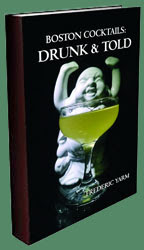
 The first aspect I set out to test was the muddler. For muddling something soft like mint in simple syrup (pictured to the left), the tool worked rather effectively. The only difference between it and my gold standard wooden muddler is the smaller surface area on the spoon's tail end. At the bottom of the mixing glass, this difference just meant a few extra strokes. Moving on to the other end of the spectrum -- the sugar cube -- the spoon's muddler seemed to falter (note: I did not even attempt to crush ice cubes). To derive the force necessary to smash the cube into powder, the spoon felt awkward to hold on to due to its narrow diameter, especially compared to the wooden muddler which fits nicely in the hand. My fingers kept sliding down the shaft, but with enough attempts, the sugar cube eventually gave way. In between these two extremes, I figure that the muddler end would be sufficient for softer items like berries and herbs; however, it would have issues in muddling citrus with the rind like in a Caipirinha or smash. Added force applied on the spoon end should be avoided since the weld holding the spoon bowl to the shaft apparently will give way. So as a muddler, it is adequate for some ingredients and it is certainly handy to have a single tool to do both, although I still prefer my sturdy wooden muddler as my go-to tool (and Dr. Freud would certainly be proud).
The first aspect I set out to test was the muddler. For muddling something soft like mint in simple syrup (pictured to the left), the tool worked rather effectively. The only difference between it and my gold standard wooden muddler is the smaller surface area on the spoon's tail end. At the bottom of the mixing glass, this difference just meant a few extra strokes. Moving on to the other end of the spectrum -- the sugar cube -- the spoon's muddler seemed to falter (note: I did not even attempt to crush ice cubes). To derive the force necessary to smash the cube into powder, the spoon felt awkward to hold on to due to its narrow diameter, especially compared to the wooden muddler which fits nicely in the hand. My fingers kept sliding down the shaft, but with enough attempts, the sugar cube eventually gave way. In between these two extremes, I figure that the muddler end would be sufficient for softer items like berries and herbs; however, it would have issues in muddling citrus with the rind like in a Caipirinha or smash. Added force applied on the spoon end should be avoided since the weld holding the spoon bowl to the shaft apparently will give way. So as a muddler, it is adequate for some ingredients and it is certainly handy to have a single tool to do both, although I still prefer my sturdy wooden muddler as my go-to tool (and Dr. Freud would certainly be proud). The second aspect I tested out was the drink layering. For standard floats, gently pouring on the back side of any barspoon or teaspoon with its edge touching the glass works so the flat end seems excessive for this purpose. However, for making a pousse-café, a multiply layered drink, in a narrow glass, the convex part of the spoon trick is not sufficient. For a recipe to test this functionality out, I opened my copy of Boothby's World Drinks and How to Mix Them and picked the Champerelle.
The second aspect I tested out was the drink layering. For standard floats, gently pouring on the back side of any barspoon or teaspoon with its edge touching the glass works so the flat end seems excessive for this purpose. However, for making a pousse-café, a multiply layered drink, in a narrow glass, the convex part of the spoon trick is not sufficient. For a recipe to test this functionality out, I opened my copy of Boothby's World Drinks and How to Mix Them and picked the Champerelle.ChamperelleI must admit that pouring the layers with the Bonzer's flat end was a little tedious but not that difficult to achieve perfection on the first try (my middle transition would look better if my old bottle of Pernod had not yellowed to look similar in color to my Chartreuse). The lower I got the OXO mixing cup, the gentler the pour. Beforehand, I did experiment with starting at the top of the spiraled shaft with some water but this caused drops to fly off before landing at the flattened base. At a height of a few inches, the stream adhered beautifully to the shaft quite well. Keeping the OXO mixing cup touching the shaft and the edge of the flattened base touching the side and slightly above the surface was not that difficult to achieve even with several slow pours.
(1) 1/4 jigger Curaçao
(2) 1/4 jigger Anisette (Pernod)
(3) 1/4 jigger Chartreuse (Green)
(4) 1/4 jigger Cognac (Courvoisier VS)
(5) few drops Bitters (Fee's Whiskey Barrel)
Pour carefully, as numbered, into chilled pousse-café glass, so that ingredients will not mix, and serve with cut straws and ice water chaser.
Overall, I rather like my Bonzer barspoon. It has a great feel in the hand as opposed to a straight, untextured shaft. The muddler is handy in a pinch although it will not be my tool of choice; however, the layerer is quite superior to anything I own especially for depth and precision work. At $13-14, the Bonzer barspoon is more pricey than say my $3 eBay one, but it is a lot more stylish and handy for certain advanced techniques. And oh yeah, it stirs drinks too!
 The 2017 collection of 855 drink recipes, bartender tributes, and essays on hospitality from CocktailVirgin's Frederic Yarm. Available at
The 2017 collection of 855 drink recipes, bartender tributes, and essays on hospitality from CocktailVirgin's Frederic Yarm. Available at  The 2012 collection of 505 drink recipes, techniques, and Boston bar recommendations from Frederic Yarm. Available at
The 2012 collection of 505 drink recipes, techniques, and Boston bar recommendations from Frederic Yarm. Available at 




1 comment:
Here in Australia I use the muddling end on bitters soaked cubes, making it perfect for old fashioned and other things you're knocking up on the bar in front of the patron. A baseball bat can look a touch unwieldy in those situations. I guess it would struggle to crush an unsoaked cube, but then why wouldn't you use a regular sugar then anyway?
Post a Comment